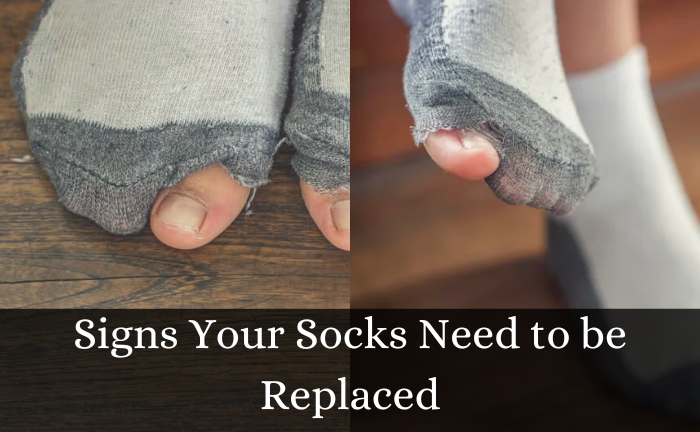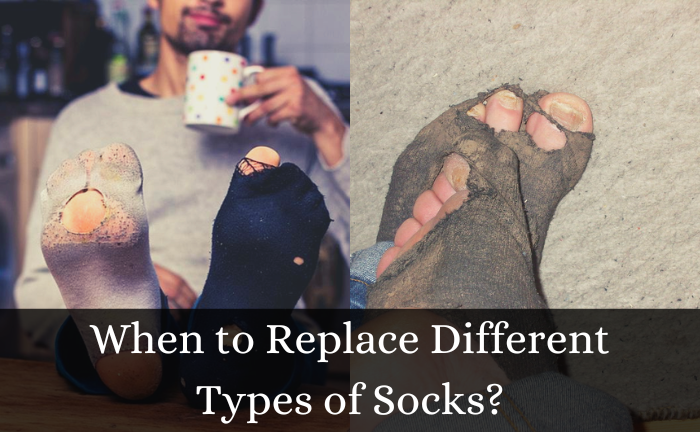Socks are an essential part of our daily attire. They not only keep our feet warm and comfortable but also play a vital role in protecting our feet from blisters, fungal infections, and other foot-related problems. However, like any other piece of clothing, socks also have a limited lifespan, and eventually, they must be replaced.
It would be best to throw out your socks after noticing these signs.
- Smell test
- Holes and tears
- Loss of elasticity
- Discoloration
- Frayed edges
And a few more. In this article, you’ll learn about the signs that indicate it’s time to throw out your socks.
Signs Your Socks Need to be Replaced

Here are the signs that your socks need to be replaced.
The Smell Test
One of the most obvious signs that it’s time to replace your socks is the smell. Socks can get smelly after a while, especially if you wear them for extended periods or engage in activities that cause your feet to sweat.
If your socks smell bad even after washing, it’s time to toss them out. The smell is a sign that bacteria has built up in the fabric of your socks, and it can be difficult to remove altogether.
Holes and Tears
Another sign that it’s time to replace your socks is the presence of holes or tears. Socks can develop spots over time, especially if you wear them frequently or are made of low-quality material.
When you notice holes or tears in your socks, it’s time to replace them. Wearing socks with holes or tears can cause discomfort and even lead to blisters, which can be painful.
Loss of Elasticity
Socks are designed to fit snugly around your feet and ankles, and they accomplish this with the help of elastic fibers. Over time, however, the elastic in your socks can wear out, causing them to lose shape and become loose.
If your socks are no longer fitting snugly around your feet, it’s time to replace them. Loose socks can bunch up and cause discomfort, which can be particularly annoying if you’re on the move.
Discoloration
Socks can become discolored over time, especially if you wear them frequently. Discoloration can be caused by sweat, dirt, and other factors, which can be challenging to remove.
If your socks are discolored and no longer look clean, it’s time to replace them. Wearing discolored socks can make you feel self-conscious and uncomfortable, especially in a professional setting.
Frayed Edges
The edges of your socks can become frayed over time, especially if you wear them frequently or are made of low-quality material. Frayed edges can cause discomfort and make it difficult to put your socks on and take them off.
If your socks have frayed edges, it’s time to replace them. Wearing socks with frayed edges can also cause them to wear out more quickly, developing holes and tears.
Size and Fit
Socks come in different sizes and fits, and it’s essential to choose the right one for your feet. Wearing socks that are too small or too big can lead to discomfort and blisters.
Over time, socks can stretch out and lose shape, leading to ill-fitting socks. If you notice that your socks no longer fit properly or feel uncomfortable, it’s time to throw them out and invest in a new pair.
When to Replace Different Types of Socks?

Here’s a guide on when to replace different types of socks
Athletic socks
If you use athletic socks regularly for running or exercising, you should replace them every six months. This is because the constant movement and sweat buildup can cause them to wear out faster.
Dress socks
Dress socks are usually made from thinner materials than athletic socks so they can wear out faster. It’s recommended to replace them every year if you wear them frequently.
Wool socks
Wool socks are known for their durability and longevity, but they must be replaced over time. Depending on how frequently you wear them, you should replace them every 2-3 years.
Cotton socks
Cotton socks are the most commonly used type of socks, and they are also the most affordable. However, they tend to wear out quickly, skinny ones. You should replace them every 6-12 months.
Compression socks
Compression socks are designed to provide support and increase circulation in your legs. They can lose their compression over time, so it’s recommended to replace them every 6 months to a year, depending on how often you wear them.
How to Take Care of Your Socks?
To make your socks last longer, you must take proper care of them. Here are some tips to help you take care of your socks.
- Sort your socks: Before washing, sort your socks according to color and fabric. This will help prevent any bleeding of color or damage to delicate fabrics.
- Check the care label: Always check the care label on your socks before washing. Some socks may require hand-washing or special care instructions.
- Wash your socks in cold water: It is recommended to wash your socks in cold water, as hot water can damage the fibers and cause shrinkage. Use a gentle detergent and avoid using bleach.
- Use a laundry bag: To prevent losing your socks in the wash, it’s a good idea to place them in a laundry bag or pillowcase before washing them. This will also help prevent stretching or snagging.
- Avoid tumble-drying: It’s best to air-dry your socks, as tumble-drying can cause shrinkage and damage to the fibers. Hang your stockings up to dry or lay them flat.
- Store your socks properly: Once clean and dry, store them in a cool, dry place. Avoid folding them, as this can cause creases and damage the fabric. Instead, roll them up and place them in a drawer or organizer.
By following these tips, you can help ensure your socks last longer and maintain quality. Remember, proper care and maintenance of your socks can go a long way in keeping your feet happy and healthy.
Conclusion
In conclusion, it’s essential to know when to throw out your socks to ensure that your feet stay healthy and comfortable. When the fabric is worn out, the elastic is stretched out, they start to smell, they lose their shape, or they’ve been worn for a long time.
It’s time to replace them. By following these guidelines, you can ensure that your feet stay happy and healthy.
